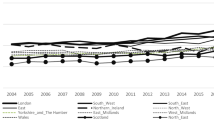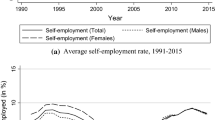Abstract
This paper studies the convergence of self-employment by gender in the European Union, through tests for the order of integration and cluster analysis, in order to investigate the occurrence of two types of convergence: between genders and among European countries. The paper makes two contributions to the literature: (1) theoretically, it provides useful insights into the macroeconomic determinants of self-employment; (2) methodologically, it uses unit roots, fractional integration and cluster analysis to assess convergence. The empirical results point at mixed evidence of convergence, but with clear differences between the core and the periphery of Europe.








Similar content being viewed by others
Notes
Fritsch et al. (2015) show that Germany experienced a unique rise in the level of self-employment in the first two decades following unification. The factors driving the overall level of self-employment are demographic developments, the shift towards service sector employment, and a larger share of population holding a tertiary degree.
Technology can be imitative or research-based as emphasized by Minniti and Lévesque (2010). The type of entrepreneur [imitator or creator] is more important depending on the type of country (Goel and Ram 1994, and Gong and Keller 2003). Rich countries would have more creators, while entrepreneurs in poor countries would more likely be imitators.
Henrekson and Sanandaji (2014) conclude that small business activity does not measure entrepreneurship, and the rate of billionaire entrepreneurship (considered to have high-impact/ to be of Schumpeterian type) negatively correlates (cross-county) with SE.
See Gil-Alana and Robinson (1997) for the specific functional form of the testing approach employed here.
Eurostat defines a self-employed person as “the sole or joint owner of the unincorporated enterprise (one that has not been incorporated i.e. formed into a legal corporation) in which he/she works, unless they are also in paid employment which is their main activity (in that case, they are considered to be employees)” (retrieved from https://ec.europa.eu/eurostat/statistics-explained/index.php/Glossary:Self-employed on 22/06/2020).
In the EU, the promotion of self-employment is reflected in the Europe 2020 Strategy.
References
Acs ZJ (2006) How is entrepreneurship good for economic growth? Innov: TechnolGov Glob 1(1):97–107
Andersson P, Wadensjö E (2007) Do the unemployed become successful entrepreneurs? Int J Manpower 28:604–626
Baldassarini A (2015) Self-employment and the economic crisis in Europe. Social Situation Monitor Seminar on self-employment, 21 May
Barro RJ, Sala-i-Martin X (1991) Convergence across states and regions. Brook Papers Econ Act 1:107–182
Bendick M, Egan ML (1987) Transfer payment diversion for small business development: British and French experience. IndLaborRelat Rev 40:528–542
Bernard AB, Durlauf SN (1995) Convergence in international outputs. J of Appl Econ 10:97–108
Block J, Colombo M, Cumming D, Vismara S (2018) New players in entrepreneurial finance and why they are there. Small Bus Econ 50:239–250
Boudreaux CJ (2017) Institutional quality and innovation: some cross-country evidence. J Ent Pub Pol 6:26–40
Brown S, Farrell L, Harris M, Sessions J (2006) Risk preference and employment contract type. J Royal Stat Soc, Series A 169:849–863
Cumming D, Johan S, Zhang M (2014) The economic impact of entrepreneurship: comparing international datasets. Corp Gov: An Int Rev 22:162–178
Dawson C, Henley A, Latreille P (2014) individual motives for choosing self-employment in the UK: does region matter? Reg Stud 48(5):804–822
Dickey DA, Fuller WA (1979) Distributions of the estimators for autoregressive time series with a unit root. J Am Stat Assoc 74(366):427–481
Diebold FX, Inoue A (2001) Long memory and regime switching. J Econ 105:131–159
Diebold FX, Rudebusch GD (1991) On the power of dickey-fuller tests against fractional alternatives. Econ Lett 35:155–160
Dunn T, Holtz-Eakin D (2000) Financial capital, human capital and the transition to self-employment: evidence from intergenerational links. J Lab Econ 18:282–305
Evans DS, Leighton LS (1989) Some empirical aspects of entrepreneurship. American Econ Rev 79:519–535
Faria JR (2015) Entrepreneurship and business cycles: technological innovations and unemployment. IntEntrepManag J 11:253–265
Faria JR, Cuestas JC, Gil-Alana LA (2009) Unemployment and entrepreneurship: a cyclical relationship? Econ Lett 105:318–320
Faria JR, McAdam P (2013) Anticipation of future consumption: a monetary perspective. J Money Credit Bank 45:423–447
Faria JR, Cuestas JC, Mourelle E (2010) Unemployment and entrepreneurship: a cyclical relationship? Econ Model 27:1282–1291
Faria JR, Wu Z (2012) From unemployed to entrepreneur: the role of absolute bequest motive. Econ Lett 114:10–123
Fernandes C, Raposo M, Ferreira J, Thurik R, Faria J (2015) Entrepreneur location decisions across industries. IntEntrepManag J 12:985–1006
Ferreira JJ, Fernandes CI (2015) Entrepreneurship and location: the cultural differences between two countries. In: Peris-Ortiz M, Merigó-Lindahl J (eds) Entrepreneurship, regional development and culture. Springer, New York
Fondeville N, Ozdemir E, Lelkes O and Ward T (2015) Recent changes in self-employment and entrepreneurship across the EU. Research note No.15 June.
Friedman M (1957) The permanent income hypothesis a theory of the consumption function. Princeton University Press, Princeton
Fritsch MA, Kritikos S, Sorgner A (2015) Why did self-employment increase so strongly in Germany? EntrepReg Dev 67:307–333
Gil-Alana LA, Robinson PM (1997) Testing of unit roots and other nonstationary hypothesis in macroeconomic time series. J Econ 80(2):241–268
Goel RK, Göktepe-Hultén D (2013) Nascent entrepreneurship and inventive activity: a somewhat new perspective. J Technol Transfer 38:471–485
Goel RK, Ram R (1994) Research and development expenditures and economic growth: a cross-country study. Econ Dev Cult Change 42:403–412
Goetz SJ, Fleming DA, Rupasingha A (2012) The economic impacts of self-employment. J AgricAppl Econ 44(3):315–321
Gong G, Keller W (2003) Convergence and polarization in the global income levels: a review of recent results on the role of international technology diffusion. Res Policy 32:1055–1079
Granger CWJ, Hyung N (2004) Occasional structural breaks and long memory with an application to the S and P 500 absolute stock returns. J EmpirFinanc 11:399–421
Hassler U, Wolters J (1994) On the power of unit root tests against fractional alternatives. Econ Lett 45:1–5
Hatfield I (2015) Self‐employment in Europe, Report (UK: Institute for Public Policy Research (IPPR))
Henrekson M and Sanandaji T (2014) Small business activity does not measure entrepreneurship. Proceedings of the National Academy of Sciences, Feb 4 111(5): 1760–1765
Henrekson, M and Sanandaji T (2019) Measuring Entrepreneurship: Do Established Metrics Capture High-Impact Schumpeterian Entrepreneurship? Entrepreneurship Theory and Practice. forthcoming.
Holtz-Eakin D, Joulfaian D, Rosen HS (1993) Thecarnegie conjecture: some empirical evidence. Quart J Econ 108:413–435
Joulfaian D, Wilhelm MO (1994) Inheritance and labor supply. J Human Res 29:1205–1234
Knight FK (1921) Risk Uncertainty and Profit. Houghton Mifflin, New York
Koellinger PD, Thurik AR (2012) Entrepreneurship and the business cycle. Rev Econ Stat 94:1143–1156
Lee D, Schmidt P (1996) On the power of the KPSS test of stationarity against fractionally integrated alternatives. J Econ 73:285–302
Minniti M, Lévesque M (2010) Entrepreneurial types and economic growth. J Bus Ventur 25:305–314
Monfort M, Cuestas JC, Ordóñez J (2013) Real convergence in Europe: a cluster analysis. Econ Model 33:689–694
Monteiro G, Turnovsky SJ (2016) Anticipated consumption and its impact on capital accumulation and growth. Int J Econ Theory 12:203–232
Ng S, Perron P (2001) Lag selection and the construction of unit root tests with good size and power. Econometrica 69:1519–1554
Nittykangas H, Tervo H (2005) Spatial variations in intergenerational transmission of self-employment. Regional Studies 39:319–332
Ohanissian A, Russell JR, Tsay RS (2008) True or spurious long memory? A new test. J Bus Econ Stat 26(2):161–175
Parker S (2018) Economics of Entrepreneurship. Cambridge University Press, Cambridge
Phillips PCB, Perron P (1988) Testing for a unit root in time series regression. Biometrika 75:335–346
Prachowny M (1993) Okun’s law: theoretical foundations and revised estimates. Rev Econ Stat 75:331–336
Saridakis G, Mendoza Gonzalez MA, Muñoz Torres RI, Hand C (2019) Do self-employment rates converge? evidence from European OECD Countries. J Common Mark Stud 57(3):551–562
Schumpeter JA (1934) The theory of economic development. Harvard University Press, Cambridge
Svaleryd H (2014) Self-employment and the local business cycle. Small Bus Econ 44:55–70
Terjensen S, Hessels J, Li D (2016) Comparative international entrepreneurship: a review and research agenda. J Manag 42:299–344
Thurik AR (2009) Entreprenomics: entrepreneurship, economic growth and policy. In: Acs ZJ, Audretsch DB, Strom R (eds) Entrepreneurship, growth and public policy. Cambridge University Press, Cambridge, pp 219–249
van Stel A, Carree M, Thurik AR (2005) The effect of entrepreneurial activity on national economic growth. Small Bus Econ J 24:311–321
Verheul I, Van Stel A, Thurik R (2006) Explaining female and male entrepreneurship at the country level. EntrepReg Dev 18(2):151–183
Weixel A (2014) Womentrepreneurship after the great recession: an empirical analysis of female entrepreneurship rates in Europe. CMC Senior Theses, Paper 968
Wennekers S, Thurik AR (1999) Linking entrepreneurship and economic growth. Small Bus Econ J 13:27–56
Acknowledgements
Juan Carlos Cuestas acknowledges the financial support from the MINEIC-AEI-FEDER ECO2017-85503-R and ECO2017-83255-C3-3-P projects both of them from ‘Ministerio de Economía, Industria y Competitividad’ (MINEIC), `Agencia Estatal de Investigación' (AEI) Spain and `Fondo Europeo de Desarrollo Regional' (FEDER), and the UJI project UJI-B2019-15. The first of these projects is also acknowledged by Luis A. Gil-Alana.
Author information
Authors and Affiliations
Corresponding author
Additional information
Publisher's Note
Springer Nature remains neutral with regard to jurisdictional claims in published maps and institutional affiliations.
Rights and permissions
About this article
Cite this article
Faria, J.R., Cuestas, J.C., Gil-Alana, L. et al. Self-employment by gender in the EU: convergence and clusters. Empirica 48, 717–741 (2021). https://doi.org/10.1007/s10663-020-09494-2
Accepted:
Published:
Issue Date:
DOI: https://doi.org/10.1007/s10663-020-09494-2




